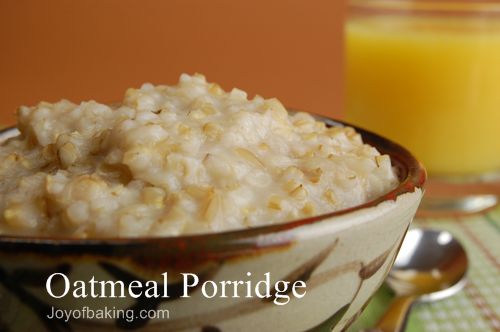|

As
a child, cold winter mornings would often begin with the wonderful smell of
oats cooking on the stove. Once that steaming bowl of hot porridge
was placed before me I would dress it with a spoonful of soft brown sugar
and, if we were lucky, rich cream that had been skimmed off the top of the
milk. The porridge of my
youth, made with rolled oats, is not what I eat today. Then, my mother
used 'rolled' oats which are
oats that have been
cleaned, toasted, hulled, steamed and then flattened into flakes and,
depending on the thickness of the flakes, are labeled either 'old-fashioned' or
'quick-cooking' (old-fashioned being thicker than quick cooking). Today
I make my porridge with
'steel-cut' Irish Oatmeal which has a hearty oat flavor and chewy, not mushy, texture.
Steel-cut oatmeal and rolled oats look very different from each
other, for steel-cut means the oats are 'cut' not 'rolled', so instead of
flakes of oats you have tiny hard bits of golden oatmeal (think of mini
rice particles). Of course, it is always nice to consult an expert when
making a new dish, so for advise on making a good bowl of porridge I
turned to Marian McNeill and her cookbook Recipes from Scotland. Her advise is sound; start with
a good quality oatmeal, fresh spring water (or at least filtered), and a
thick bottomed pot. Boil the water and then add the oatmeal
by "letting it fall in a steady rain
from the left hand whilst you stir it with the right". Add a
little salt and then cook the oatmeal until it is of good taste and
quality, usually between 20 - 30 minutes. Do not overcook or you
will end up with a "gluey, flavourless mess". The interesting part of
her instructions is how you should eat your porridge. She tells us
to have two bowls; one bowl for the porridge and another bowl for cold
milk or cream. You are to first dip your spoon in the porridge and
then take the spoonful of hot porridge and dip it into the cold milk.
This has the delicious contrast of hot oatmeal and shocking cold
milk.
It is little wonder that she refers to porridge as "food for the gods".
In
North America, the most readily available 'steel-cut' Irish Oatmeal is 'John McCann's Irish Oatmeal'. It is
sold in 28 ounce (783 gram) metal canisters. You can find
this brand at some grocery stores, most specialty food stores or
on-line. |